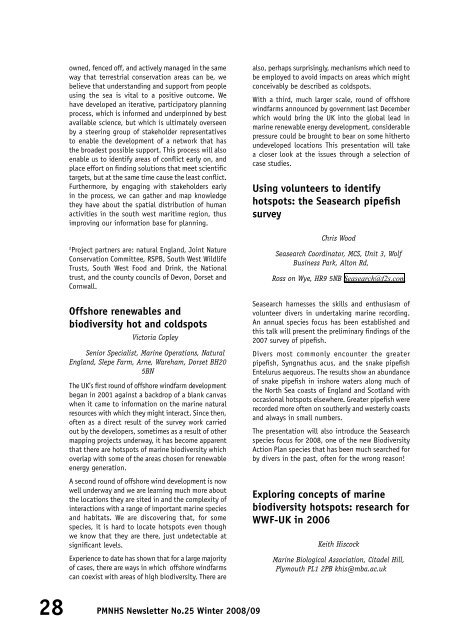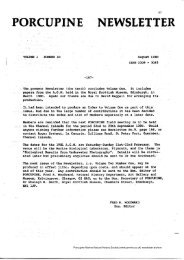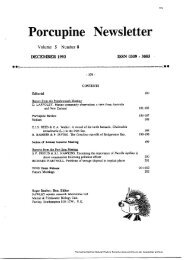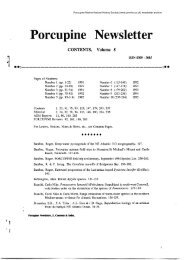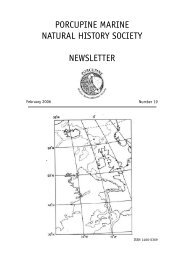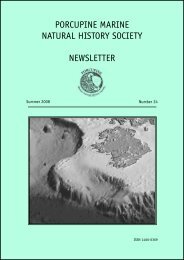owned, fenced off, and actively managed in the sameway that terrestrial conservation areas can be, webelieve that understanding and support from peopleusing the sea is vital to a positive outcome. Wehave developed an iterative, participatory planningprocess, which is informed and underpinned by bestavailable science, but which is ultimately overseenby a steering group of stakeholder representativesto enable the development of a network that hasthe broadest possible support. This process will alsoenable us to identify areas of conflict early on, andplace effort on finding solutions that meet scientifictargets, but at the same time cause the least conflict.Furthermore, by engaging with stakeholders earlyin the process, we can gather and map knowledgethey have about the spatial distribution of humanactivities in the south west maritime region, thusimproving our information base for planning.2Project partners are: natural England, Joint NatureConservation Committee, RSPB, South West WildlifeTrusts, South West Food and Drink, the Nationaltrust, and the county councils of Devon, Dorset andCornwall.Offshore renewables andbiodiversity hot and coldspotsVictoria CopleySenior Specialist, Marine Operations, NaturalEngland, Slepe Farm, Arne, Wareham, Dorset BH205BNThe UK’s first round of offshore windfarm developmentbegan in 2001 against a backdrop of a blank canvaswhen it came to information on the marine naturalresources with which they might interact. Since then,often as a direct result of the survey work carriedout by the developers, sometimes as a result of othermapping projects underway, it has become apparentthat there are hotspots of marine biodiversity whichoverlap with some of the areas chosen for renewableenergy generation.A second round of offshore wind development is nowwell underway and we are learning much more aboutthe locations they are sited in and the complexity ofinteractions with a range of important marine speciesand habitats. We are discovering that, for somespecies, it is hard to locate hotspots even thoughwe know that they are there, just undetectable atsignificant levels.Experience to date has shown that for a large majorityof cases, there are ways in which offshore windfarmscan coexist with areas of high biodiversity. There arealso, perhaps surprisingly, mechanisms which need tobe employed to avoid impacts on areas which mightconceivably be described as coldspots.With a third, much larger scale, round of offshorewindfarms announced by government last Decemberwhich would bring the UK into the global lead inmarine renewable energy development, considerablepressure could be brought to bear on some hithertoundeveloped locations This presentation will takea closer look at the issues through a selection ofcase studies.Using volunteers to identifyhotspots: the Seasearch pipefishsurveyChris WoodSeasearch Coordinator, MCS, Unit 3, WolfBusiness Park, Alton Rd,Ross on Wye, HR9 5NB Seasearch@f2s.comSeasearch harnesses the skills and enthusiasm ofvolunteer divers in undertaking marine recording.An annual species focus has been established andthis talk will present the preliminary findings of the2007 survey of pipefish.Divers most commonly encounter the greaterpipefish, Syngnathus acus, and the snake pipefishEntelurus aequoreus. The results show an abundanceof snake pipefish in inshore waters along much ofthe North Sea coasts of England and Scotland withoccasional hotspots elsewhere. Greater pipefish wererecorded more often on southerly and westerly coastsand always in small numbers.The presentation will also introduce the Seasearchspecies focus for <strong>2008</strong>, one of the new BiodiversityAction Plan species that has been much searched forby divers in the past, often for the wrong reason!Exploring concepts of marinebiodiversity hotspots: research forWWF-UK in 2006Keith HiscockMarine Biological Association, Citadel Hill,Plymouth PL1 2PB khis@mba.ac.uk28PMNHS <strong>Newsletter</strong> No.<strong>25</strong> <strong>Winter</strong> <strong>2008</strong>/09
Marine biodiversity hotspots are areas of highspecies and habitat richness that includerepresentative, rare and threatened features 1 .The idea of identifying biodiversity hotspots whereconservation effort can be concentrated to getbest ‘value for money’ is an attractive one that hasbeen extensively promoted for terrestrial habitats.In 2006, the Marine Biological Association wascommissioned by WWF-UK to explore how the conceptof biodiversity hotspots could be developed for themarine environment. The work involved a great dealof data analysis using a ‘snapshot’ of Marine Recorderfrom February 2006. The report 1 , by Keith Hiscock andMark Breckels, described how data from 120 areasaround the UK, that had adequate information tomake comparison a reasonable prospect, was usedto identify ‘hotspots’ for six measures of ‘richness’including for species, biotopes and for NationallyImportant Marine Features.Endemism is an important criterion to identifyhotspots on the land and in freshwater but is anunusual feature in the marine environment ofthe north-east Atlantic and there are no marinespecies believed endemic to anywhere in the UK.However, hotspots should include rare or threatenedspecies and habitats (which have been identified as‘Nationally Important Marine Features’ in the UK)and the more present at a particular location, thebetter ‘value for money’.For hotspot measures, we concluded that:The results of analysis broadly match the locationsthat are believed to be of high interest.The wide range of types of data maintained requires‘minimum standards’ to be applied to identifyacceptability.The measures developed (in which number of surveyevents at a location are taken into account inidentifying hotspot status) require more developmentas naturally rich areas tend to be downgraded ifthey are very well surveyed. To take account of thisproblem, a ‘weighting’ was applied to such sites.Some locations are naturally low in species andbiotope richness and their low scores need to beseen in that context.The identification of number of Nationally ImportantMarine Features in an area is an important measurebut the current list of Features needs to be furthermoderated to correct anomalies especially arisingfrom criteria-led selection.Hotspot measures are one of several tools forassessing marine natural heritage importance ofan area.The measures we tested should all be used to informthe site selection process and we demonstrated,in a series of dossiers for case study sites, howsuch scientific information can be used to supportproposals for protection and management.Issues of data ‘uneven-ness’ will be explored duringthe <strong>Porcupine</strong> MNHS meeting and, as always, theimportance of being able to access all survey datafor an area through, preferably, a single portal willbe addressed.1Hiscock, K ., Breckels, M., 2006. Marine BiodiversityHotspots in the UK: their identification andprotection. Godalming: WWF-UK. [Available from:http://www.wwf.org.uk/news/n_0000003424.asp.]Investigations into thecomposition of the bivalve faunaon the <strong>Porcupine</strong> BankPeter Barrypeter.barry@nuigalway.ieThe <strong>Porcupine</strong> Bank is an elliptical topographicfeature of the continental margin of Western Europe.Across a 10,000 km 2 area the bathymetry of thebank ranges from less than 150 to more than 3000metres off the western shelf and has a variety ofsubstrate types. It was previously believed that thebank supported upwards of 100 bivalve species, yetcompared to the surrounding Rockall Trough and<strong>Porcupine</strong> Seabight, investigation into the faunalcomposition had, until recently, been very limited.Throughout 2003 and 2004 the National University ofIreland, Galway conducted a series of surveys acrossthe bank which led to the compilation of the firstregister of bivalve species living on the bank to bemade available for more than 75 years. A total of 70species were recovered, including 22 new records forthe area and three new species. Many rare specieswere collected along the western slope which hadpreviously proved inaccessible due to the extremetopography. Vast aggregates of byssally attachedspecies were taken from the rocky boulder fields ofthe north of the bank, while carnivorous deep waterspecies dominated the assemblages of the steepwestern slope. The most speciose family found on thebank was the Thyasiridae with a total of 11 speciesrecovered in our samples. At least one representativeof this family was present in nearly every sampletaken on the bank, from the relatively shallowwater around the northern dome to the abyssalplains west of the bank. The significant results ofour investigations will be outlined along with apresentation of detailed images of the extraordinaryand less common species we encountered.PMNHS <strong>Newsletter</strong> No.<strong>25</strong> <strong>Winter</strong> <strong>2008</strong>/0929


